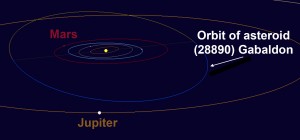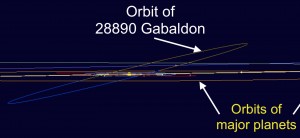 MANY thanks to the Lowell Observatory (in Flagstaff, Arizona) for including me in their wonderful “I (heart) Pluto” Festival this weekend!
MANY thanks to the Lowell Observatory (in Flagstaff, Arizona) for including me in their wonderful “I (heart) Pluto” Festival this weekend!
Everyone had a wonderful time, including State Representative Justin Wilmoth, who is introducing a bill to the Legislature declaring that “Pluto is the State Planet of Arizona.” (As the Representative noted in his remarks, “No other state has discovered a planet!”)
(Yes, we know that Pluto is dismissed as a “planetoid” by the uninformed; (most of) the good people of Flagstaff decline to accept that designation.)
The text and image below shows (most of) the certificate the Observatory folks gave me, commemorating their naming one of “their” (as in, they discovered and registered it) asteroids after me. Quite an honor!
(28890) Gabaldon = 2000 KY65
Discovery: 2000-05-27 / LONEOS / Anderson Mesa / 699
Diana J. Gabaldon (b. 1952) is an American author. After earning a PhD in behavioral ecology and working as a university professor, she became a full time writer and is known for her bestselling Outlander series of novels. Her great-grandfather, Stanley Sykes, built the telescope used to discover Pluto.
(Text above about asteroid 28890 Gabaldon is from IAU’s WGSBN Bulletin, Volume 4, No. 2, released on Feb. 5, 2024.)
Click on the illustration above to view a larger version. Credit: Lowell Observatory.
More About Asteroid 28890 Gabaldon
28890 Gabaldon is an asteroid which orbits the Sun in the main asteroid belt between Mars and Jupiter, and it takes 4.34 Earth years for it to orbit the Sun. Its distance from the Sun is about 2.5 times the distance from the Sun to the Earth. The first diagram below shows a plot of asteroid Gabaldon looking down at an angle on the plane of the Solar System:
Click on the images above and below to view an enlarged version.
The orbit of the asteroid is tilted in respect to the plane of the Solar System. Below is a plot looking at the Solar System’s major planets and asteroid Gabaldon from the “side”:
In the two diagrams above, the numerous objects in the main asteroid belt between the orbits of Mars and Jupiter are not shown. Credit: IAU Minor Planet Center (MPC).
Stanley Sykes Interview
 Not to bore everybody with my family history, but this is kind of neat: there’s a voice recording of a 16-minute interview with my great-grandfather, Stanley Sykes, made by a researcher for a collection at Northern Arizona University. The recording is dated 1949, so the sound quality isn’t crystal-clear, but it’s pretty good. He’s telling about his arrival in Flagstaff (from England—that side of the family is from Yorkshire) in 1886, and what happened thereafter….
Not to bore everybody with my family history, but this is kind of neat: there’s a voice recording of a 16-minute interview with my great-grandfather, Stanley Sykes, made by a researcher for a collection at Northern Arizona University. The recording is dated 1949, so the sound quality isn’t crystal-clear, but it’s pretty good. He’s telling about his arrival in Flagstaff (from England—that side of the family is from Yorkshire) in 1886, and what happened thereafter….
https://archive.library.nau.edu/digital/collection/cpa/id/24638/
In 1928-1929, Stanley Sykes designed and built the telescope which astronomer Clyde Tombaugh used to discover Pluto, a magnificent scientific achievement. Almost a hundred years old now, the Pluto-discovery telescope is still in operation, and you may visit it at Lowell Observatory. More about the Lawrence Lowell 13-inch telescope.
Notes on Naming Minor Planets
The person or persons who discover a new minor planet in the solar system are given the privilege of naming it. It was members of the Lowell Observatory Near-Earth-Object Search project who discovered this asteroid at their Anderson Mesa facility in northern Arizona. It usually takes years, even decades, to verify that an object is new and orbiting the Sun, and then to officially name it.
The Working Group for Small Body Nomenclature (WGSBN) is part of the International Astronomical Union (IAU) and is responsible for assigning official names to minor planets and comets in our Solar System.
Do you like astronomy and the Solar System? Did you attend the I (heart) Pluto event on February 17? Are you looking forward to the total eclipse in the U.S.A. on April 8, 2024?
Leave a web comment below with your story, if you like. These web comments are moderated, so it may take a day or two for it to appear. Your approved comment is public so please don’t post sensitive private information. Love to hear from you!



Diana,
I was sorry to miss your recent appearance at Lowell. I worked at Lowell for 35 years after landing my “dream job” there in 1980; I retired in 2015 to take care of my wife. I had already made arrangements to be on Kauai then to scatter her ashes from our favorite spot on the South Shore.
Congratulations on your new Asteroid! It is the best award Lowell can bestow, and well-deserved. And thank you for the comments about your GGF, Stanley. I was too late to know him, but I did get to maintain many of his works – including the A. Lawrence Lowell Astrographic Refractor (Pluto Telescope.) They did interview me on my departure, but I had no idea that had been going on long enough to catch Stanley – will have to listen to that one. Another interest of mine is the Beale Wagon Road, America’s first transcontinental highway. I have been researching it since “discovering” it shortly after my arrival in Flagstaff – about 35000 hours invested so far. Yes, I envision a book. The Beale Road passes close to what I believe to be Stanley and Godfrey’s cabin site at Turkey Tanks. They ran cattle there and worked at Lowell together. And please forgive me for being “nosy,” but I find it curious that in Godfrey’s book “Westerly Trend,” he does not mention his brother, Stanley. I did not get to meet either of them; perhaps leaving that page blank was a mark of respect for his brother. But it does seem to leave an incomplete record.
There is another Beale Road site further east – near Leupp – where some travelers on the Road carved their names in the rocks at the side of the Road. I mention this because I think it could be the basis for a novel. There are about 100 names there with maybe 60 being pretty legible. They include names of several members of the “Boston Parties,” the first to attempt settling near Flagstaff in the area of LeRoux Spring. That failed; some went on the CA, others to Prescott, and one shot himself. His name is there, along with the others.
Another signature belongs to Albert Franklin Banta, a most colorful character. He signed up in Missouri for the Civil War, but changed his mind, deserted, dropped the “Banta,” and headed for Mexico as Albert Franklin. He got as far at Santa Fe and spent time there in the newspaper trade. He then signed on with the passing “Governor’s Party” heading for AZ to establish it as a Territory. He started about a dozen newspapers in AZ, served as JP and in the Territorial Legislature, was a close friend of “Bucky” O’Neill, and wrote his autobiography before he died in 1924, the last survivor of the Governor’s Party. He did spend time in Mexico and one of his descendants claims he was the inspiration for Carlos Castaneda’s main character. His name is there – positioned strategically to appear to be the first. There are also several “Cureton’s;” a decorated Confederate Cavalry officer and his sons, who ran cattle this way from TX to CA in the 1870′s.
But a second, nearby rock may be the greatest enigma. It has just two signatures; one by the leader of one of the Boston Parties, and the other is “HECKELMAN 1826.” That date is remarkable. It is long before American control, and very early even for a fur trapper. Mexico had been independent for just 5 years in 1826. I have not identified him, but there was a Heckelman family of mining engineers based in Mexico City around that time. Perhaps one was here looking for mineral wealth for their new country.
Most of the names I find there have been lost to history, but as you see they hold possibilities. I have not cross-referenced them with names from other sites, like Inscription Rock near Zuni; that may be instructive. I cannot help wondering who they were and why they had left everything behind to travel this road. They represent a lot of untold stories!
I would be happy to show you the Sykes cabin site and/or the inscriptions if you like, though I recognize that you may already know them better than I (in which case I would be interested in learning from you.)
best regards,
Rich Oliver
Hi, Rich,
Love the fascinating Arizona history, especially about Diana’s great-grandfather, Stanley Sykes. So awesome that you maintained the Pluto Telescope that was designed and built by Stanley. I saw it years ago, back in the 1980s when I lived in Arizona. Congratulations on your years at Lowell Observatory!
I am a big astronomy nerd, and was privileged to work on multiple astronomy and planetary science mission instrument teams. Was so excited back in the 1980s when Diana told me about her grandfather’s work. Most folks nowadays don’t realize that the discovery of Pluto was a Big Deal! And happened at Lowell Observatory, part of Flagstaff’s rich history.
I have forwarded your web comment to Diana by email.
All best,
Loretta
Diana’s Webmistress
webmaster@dianagabaldon.com
Just a line to thank you. I have introduced an ESL student from Belarus to Outlander. She learned 42 new words in the first chapter. This is her first book to read in English. Thanks very much and I believe we have a new fan.
Met a lovely young German couple on holiday in Madeira, she is 25years old, and I am 80. The wonderful thing we had in common was Jamie Fraser !! Thank you Diana .